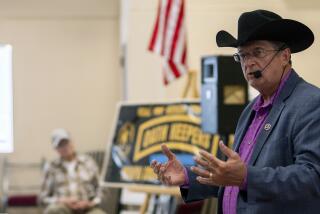Faded legacy
Every time the Atlantic partnership needs reinvigoration, U.S. presidents turn to our nation’s silent stone diplomats -- the 36 American military memorials throughout Europe.
On Saturday, the 65th anniversary of D-day, President Obama is set to address the European alliance before the same Normandy monuments President Reagan used as a backdrop for his Cold War “Boys of Pointe du Hoc” speech in 1984, a sweeping challenge to the Soviet Union.
But this “good war” magic remains a solidly European phenomenon -- whether it be D-day or most any other wartime commemoration. Far from the old Cold War frontiers, our nation’s South Pacific battlefields sit on the sidelines of great-power geopolitics.
Failure to tend the Pacific World War II legacy -- which would be a strong foundation for future engagement -- is a strategic mistake. As the Pacific Basin evolves from a safe American “lake” into a dangerous geopolitical playing field, appreciation of our World War II sacrifices there might, in the future, tip the scales in favor of peace over conflict.
Little time is left to evoke the “good war” legacy. The United States’ benign postwar presence, an experience once common to virtually every Pacific Islander, is now mostly a sepia-tinted myth preached by old-timers. The fight that helped generate new nations goes uncelebrated by the primary beneficiaries, an assemblage of 14 fledgling island democracies.
It wasn’t always this way. For decades after World War II, Pacific theater veterans could be counted on to sustain their own heritage. Survivors of the landing on Tarawa, one of the toughest U.S. fights in World War II, saved their battle memorial site in 1988, when the young democratic Republic of Kiribati decided to build a cold-storage plant on it for a Japanese fishing fleet. But now the battlefield at Red Beach, where many died, is being consumed by garbage.
Few veterans are left to fight for their history. The duty of defending Tarawa’s fading U.S. legacy has today fallen to Leon Cooper, an 89-year-old veteran and the subject of a documentary this year chronicling his campaign.
Elsewhere in the Pacific, memories of key American battlefield contributions are disappearing. In the Solomon Islands, Guadalcanal’s Henderson Field, the site of the first U.S. strategic offensive of the war and named after a Marine aviator killed in the Battle of Midway, began a re-branding process in 2003. It became the more “neutral” Honiara International Airport, named for the capital.
All memory of America’s massive wartime development project -- the establishment of a Pacific-wide logistical support network -- has almost entirely vanished.
Even living monuments -- the islanders who once served the United States -- have been neglected. Solomon Islander Eroni “Aaron” Kumana, a native coast-watcher working behind Japanese lines, helped save John F. Kennedy, our future president, whose PT boat was sunk in 1943. And although Kennedy invited Kumana to his inauguration (he was not able to attend), the hero had to wait 64 years before Washington bothered to express official gratitude. By the time Navy Secretary Donald Winter handed the old U.S scout a flag and some trinkets in 2007, Kumana was deaf and impoverished, and his small house had been destroyed by an earthquake. With no U.S. government money available to help, the crew aboard the U.S. assault ship Peleliu resorted to passing the hat.
This is no way to tend a legacy.
In today’s highly wired Internet society, where history is just a few keyboard clicks away, it is easy to forget that physical memorials, real war graves and crumbling fortifications are useful. In the Pacific, old-fashioned polished stone memorials are one of the few ways average Pacific Islanders can connect to the United States.
And at this point, America has little else to offer.
In the Solomon Islands, despite the fact that less than 2% of the population has online access, the local U.S. diplomatic presence has dwindled to a “virtual” Internet embassy. In these unconnected regions, a few granite diplomats may yet prove a better long-term investment than an unusable high-tech showpiece.
With the United States’ Pacific influence on the wane, the clock is ticking. Over the next five years, as the U.S. struggles to fund a dwindling and overtasked Navy, Russia, China, Japan, South Korea and other Asian countries are preparing to invest more than $60 billion in a regionwide naval arms race. When those new navies, all accompanied by a corps of highly trained, well-funded and active flesh-and-bone diplomats, start moving into the Pacific Basin to work to resolve festering environmental, ethnic and political problems, it will be far too late for the U.S. to start invoking past sacrifices.
More to Read
Sign up for Essential California
The most important California stories and recommendations in your inbox every morning.
You may occasionally receive promotional content from the Los Angeles Times.










